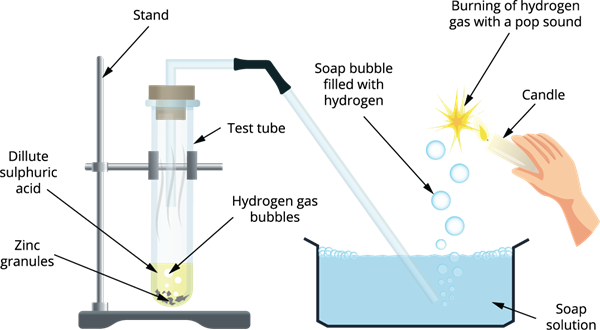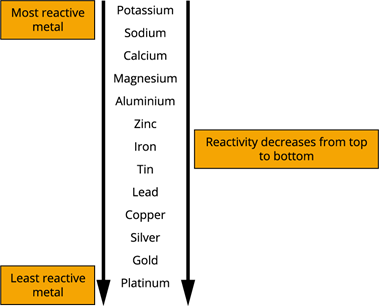PDF chapter test TRY NOW
Let us see how acid reacts with metal with the help of some activities:
Important!
Caution: The experiment should be performed in the presence of a teacher.
Example:
Activity 1: The experiment aims to see how do acids react with metals.
Apparatus required:
- Test tube
- Delivery tube
- Glass tub
- Candle
- Zinc granules
- Water
- Soap
- Dilute H_2SO_4
Step 1: Take a test tube and add 5mL of dilute sulphuric acid H_2SO_4 and add a few pinches of zinc granules.
Step 2:
- Observe the test tube for any changes.
- Fit the test tube mouth with a cork.
- Attach one end of the delivery tube to it.
Step 3: The other end of the delivery tube should be placed inside the glass tube filled with a soap solution.

Acids on reaction with metal
Observation: The liberation of gas from the reaction passes through the soap tub forming bubbles.
Result: Since the hydrogen gas does not dissolve in a soap solution, it forms hydrogen gas bubbles.
To prove that the formed gas is hydrogen, we can do a small test using a candle.
Take a burning candle near a gas-filled bubble that is formed from the above reaction. We can find the burning of hydrogen gas with a pop sound and turns the candle off.
Final observation:
- A colourless and odourless gas is formed.
- The formed gas does not dissolve in a soap solution, as a result bubbles are formed.
- The liberated gas found to be as hydrogen, which produces a pop sound and turns off the candle.
Conclusion:
dil.Sulphuric acid + Zinc granules \rightarrow Salt + Hydrogen gas
Therefore, the chemical reaction can be written as
H_2SO_4 + Zn\rightarrow ZnSO_4 + H_2
Example:
Let us now see the reaction of the other acids with zinc granules.
- Zn + 2{HCl}\rightarrow ZnCl_2 + H_2
- Zn + 2 HNO_3\rightarrow Zn(NO_3)_2 + H_2
- Zn + 2CH_3COOH\rightarrow Zn(CH_3COO)_2 + H_2
Note: When we repeat the activity with other acids such as hydrochloric acid HCl, nitric acid HNO_3 and acetic acid CH_3COOH, the same results will be produced where the formation of salts varies according to the acid.
Therefore, the overall reaction can be written as
Acid + Metal \rightarrow Salt + Hydrogen gas
It does not matter which acid or metal is used for the reaction, we always get salt along with the hydrogen gas.

Reactivity series
However, the rate of the reaction is determined by the metal used and its position in the reactivity series. The more reactive a metal is, the faster it reacts with acids.
